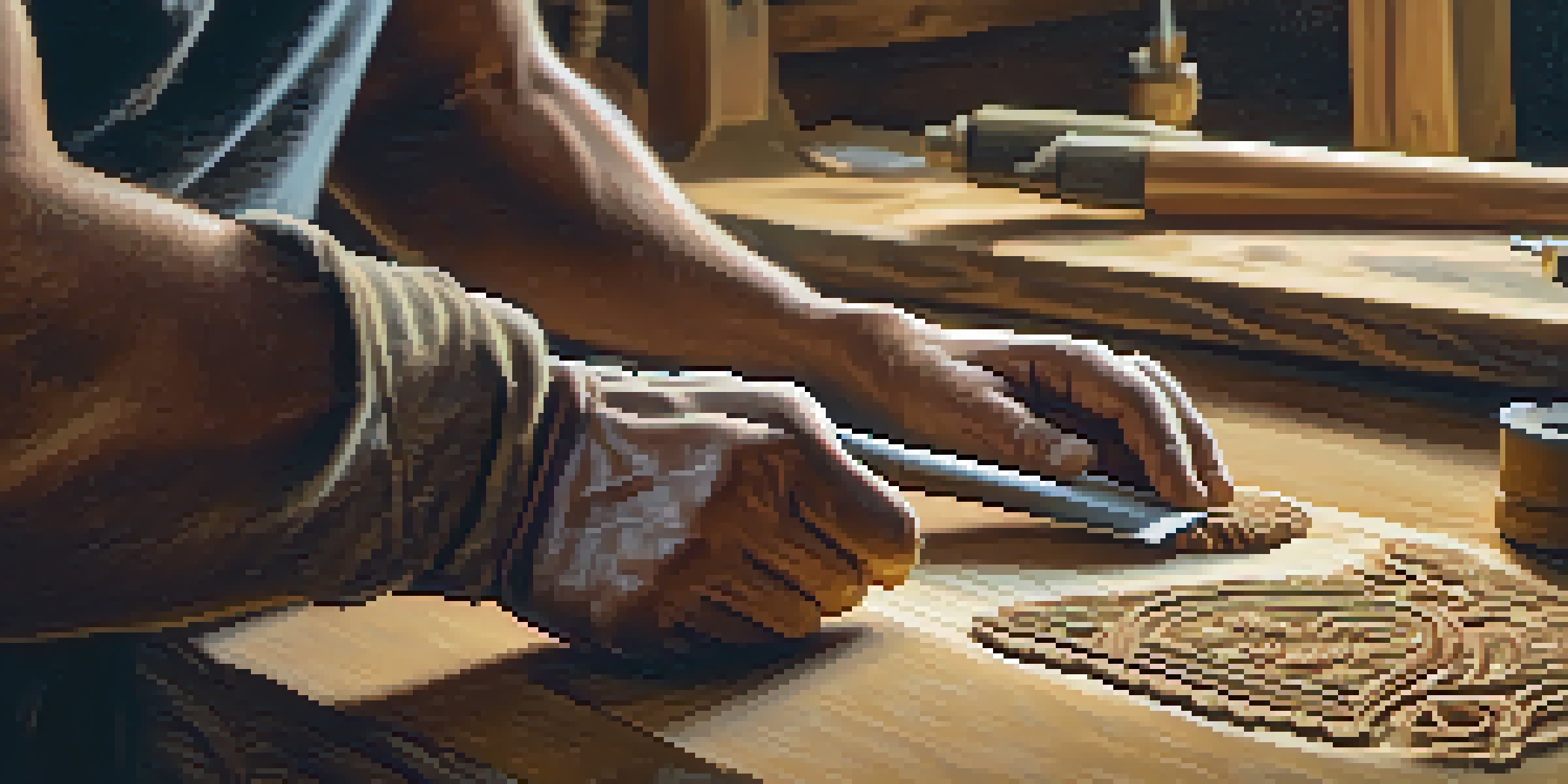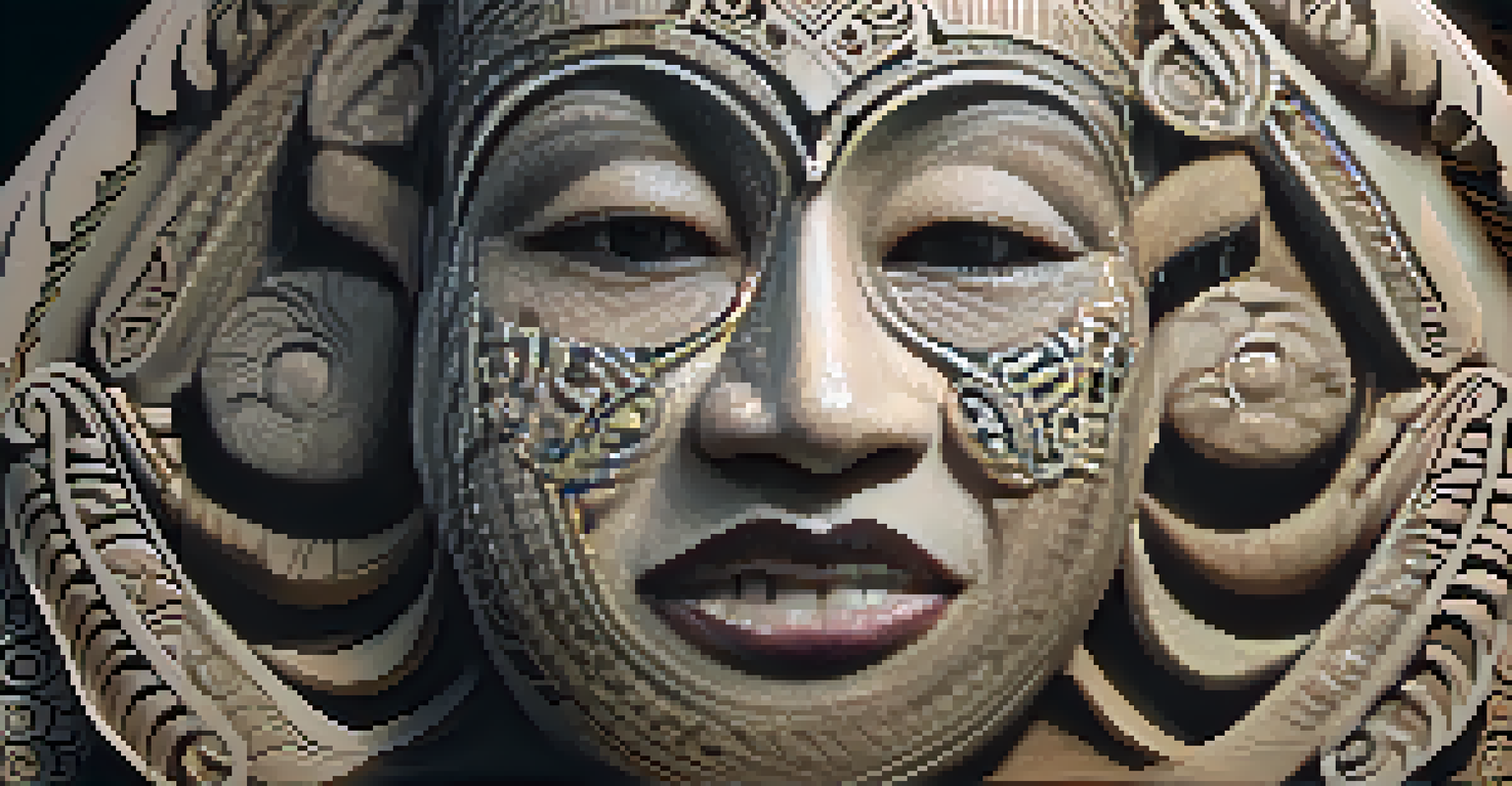Carving Techniques: A Visual Language of Cultural Stories

Understanding Carving: An Ancient Art Form
Carving is more than just shaping a material; it's a powerful storytelling medium. This ancient technique has been used across cultures to convey emotions, beliefs, and historical narratives. From totem poles in Indigenous cultures to intricate sculptures in ancient Greece, carving brings stories to life through visual representation.
Carving is the oldest and most enduring form of artistic expression, allowing us to communicate across time and cultures.
The materials used in carving vary widely, including wood, stone, and ivory, each offering unique textures and challenges. For instance, wood allows for intricate designs while stone carving demands patience and precision. Regardless of the material, the essence of storytelling remains a common thread among carvers.
Today, traditional carving techniques are preserved and celebrated, often passed down through generations. This practice not only keeps cultural stories alive but also fosters a sense of identity and community among artisans.
Cultural Significance of Carving Styles
Different cultures have developed their own distinctive carving styles, each reflecting unique histories and beliefs. For example, African tribal masks serve not only as artistic expressions but also as spiritual symbols during rituals. Similarly, the intricate designs of Maori carvings tell stories of ancestry and heritage.

These styles often incorporate specific symbols and motifs that hold deep meanings. Understanding these elements can provide insight into the values and traditions of a culture. For example, the spiral shape in Celtic carvings represents eternity and the interconnectedness of life.
Carving as a Storytelling Medium
Carving transcends mere artistry, serving as a powerful means of storytelling that conveys emotions, beliefs, and cultural narratives.
As globalization continues to blur cultural lines, preserving these unique carving styles has become increasingly important. They serve as a reminder of the rich tapestry of human experience and the stories that connect us all.
Techniques: From Traditional to Contemporary Methods
Carving techniques have evolved significantly over time, blending traditional practices with contemporary methods. While some artisans stick to hand tools and time-honored techniques, others incorporate modern technology, like CNC machines, to achieve precision and efficiency. This fusion allows for innovative expressions while honoring the past.
Art is the most beautiful of all lies; it is the truth that is felt.
For instance, traditional wood carving often employs chisels and mallets, requiring immense skill and patience. In contrast, contemporary techniques might involve laser cutting, which can create intricate designs quickly and accurately. However, this shift raises questions about authenticity and the soul of the craft.
Ultimately, whether through traditional or modern methods, the core essence of carving as a storytelling medium endures. Each technique brings its own unique voice to the narrative, enriching the cultural tapestry.
Symbolism in Carving: Decoding Messages
Every carved object often carries symbolic meanings, serving as a bridge between the artist's intent and the viewer's interpretation. For instance, an eagle carved from wood may symbolize freedom and strength in one culture, while in another, it could represent a spiritual guardian. This multifaceted nature of symbolism adds depth to the art.
Carvers often use specific shapes and elements to convey messages or tell stories. For example, the sun motif might signify life and renewal, while animal figures can represent traits admired within a culture. Understanding these symbols enriches our appreciation for the art and the stories behind it.
Cultural Identity Through Carving
The practice of carving is deeply intertwined with cultural identity, allowing communities to preserve their heritage and express shared values.
As viewers, we engage with these symbols, allowing our interpretations to evolve. This interaction not only deepens our connection to the artwork but also highlights the universality of storytelling through carving.
Carving Techniques in Religious and Spiritual Contexts
Many cultures have used carving techniques in religious and spiritual practices, creating objects that hold profound significance. For example, Hindu temples often feature intricate stone carvings depicting deities and mythological scenes, serving as a visual narrative of their beliefs. These carvings guide worshippers and tell the stories of their faith.
Similarly, Buddhist sculptures are meticulously carved to embody teachings and ideals. Each figure and posture is intentional, conveying messages of peace, enlightenment, and compassion. The spiritual context of these carvings transforms them into more than mere art; they become vessels of faith.
As we explore these spiritual carvings, we see how they foster a connection between the material and the divine. They remind us that carving is not only an art form but also a medium through which cultures express their deepest values and beliefs.
The Role of Carving in Cultural Identity
Carving techniques play a vital role in shaping cultural identity, offering a sense of belonging and continuity. For many communities, the practice of carving is intertwined with their history and traditions. By engaging in this art form, artisans connect with their ancestors and preserve their heritage.
Moreover, carving can serve as a means of cultural expression in a rapidly changing world. It allows communities to share their stories, values, and experiences with others, fostering understanding and appreciation. For instance, Indigenous artists often use carving to reclaim and share their cultural narratives, which have been marginalized.
Preserving Carving Traditions
Efforts to preserve carving traditions are essential for passing down techniques and stories to future generations, fostering appreciation for cultural diversity.
Through carving, individuals not only tell their stories but also contribute to a collective cultural identity. This ongoing dialogue between past and present ensures that these narratives remain alive, enriching our shared human experience.
Preserving Carving Traditions for Future Generations
As the world evolves, the preservation of carving traditions has become increasingly important. Many artisans and cultural organizations actively work to keep these techniques alive, ensuring that future generations can continue to tell their stories through this medium. Workshops, apprenticeships, and community initiatives play a crucial role in this endeavor.
In addition to preserving traditional methods, there's a growing movement to document and share these practices digitally. Online platforms and social media provide a space for artisans to showcase their work, share techniques, and connect with a global audience. This visibility helps raise awareness about the significance of carving traditions.

By valuing and investing in these preservation efforts, we honor the stories and histories embedded in carving. It's a collective responsibility that allows us to celebrate cultural diversity and the rich narratives that shape our world.